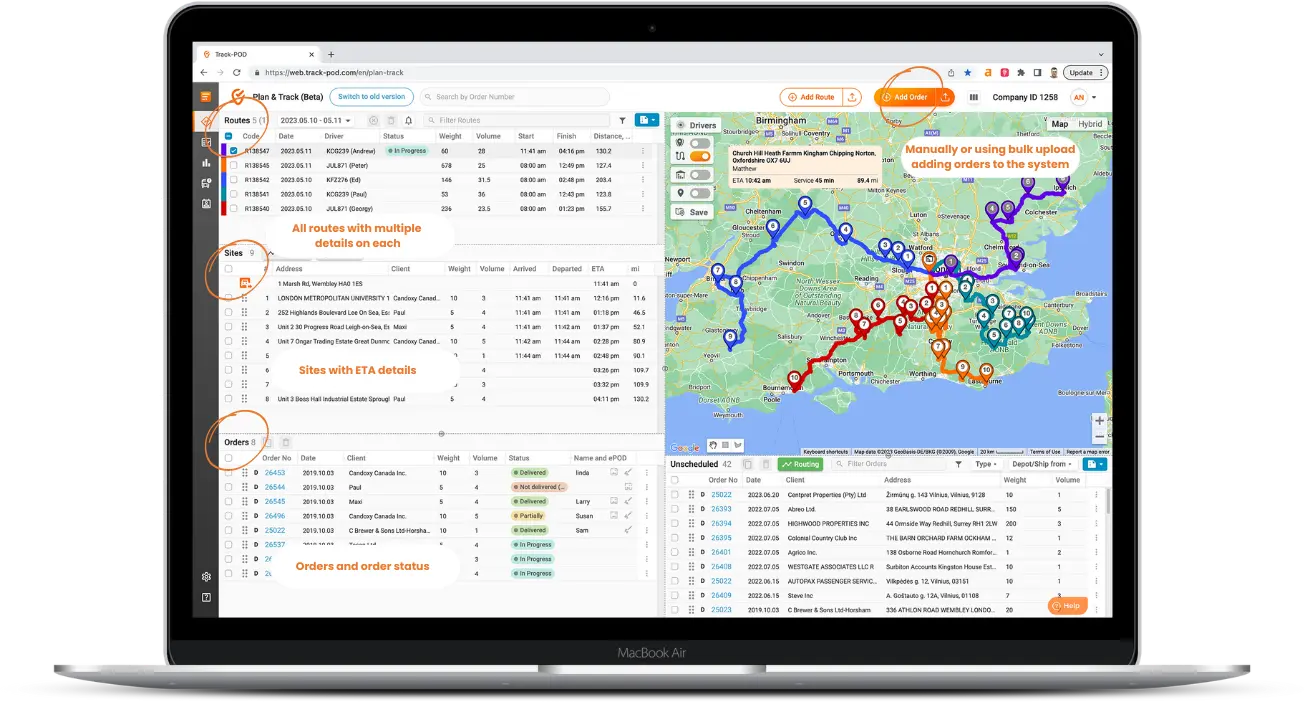Truck Route Planner: What Can It Do For Your Business
Trucking is an expensive business, with fuel and fleet maintenance costs constantly on the rise. Learn how to use a truck route planner to nail truck routing.
Read More

If you work in logistics, route planning should be your number one priority, along with customer satisfaction. Without planned routes, it’s not so easy to keep track of your trucks, and you may find that your delivery schedules are not as efficient as they could be.
Of equal importance is route optimization. But surely planning and optimization are one and the same, you may ask? Well, not quite.
In this blog article, we will discuss route planning in logistics and explain how to optimize and plan your routes. We also suggest some simple changes in your logistics environment to enhance your delivery operations.
Some of the points that will be discussed:
Table of contents:
- The difference between route planning and optimization
- How does route planning and optimization work?
- Route optimization
- Route planning
Some fleet managers and business owners still plan their routes manually using pen and paper, while others use spreadsheets to speed up the process. All of those are inefficient strategies that are time-consuming and involve a lot of human error.
1. Upload your orders with order details, such as addresses, contact details, estimated ETA, and more if needed.
2. Entering driver information, drivers' availability, contact details, and working hours
3. Adding vehicle information. That could even involve vehicle capacity for efficient load planning.
See the Track-POD example below on how easy it is to build routes! Moreover, you get single dashboard delivery management software that is easy to navigate. See some of the information that is being presented and considered within the software below.

When optimizing routes, the planner considers external factors. This includes:
With automated route planning, you enter the truck capacities in terms of size, volume, and weight. This data combines satellite technology and traffic management data for optimized routes. The software automatically produces a delivery schedule for each vehicle. With improved route scheduling, you maybe able to cut down on the number of vehicles needed. And you can still deliver an excellent service to your customers. You may be able to take on more work or redirect those vehicles into another area of your business.
Track-POD software, as an example, goes far beyond just considering order information with route optimization; it also can reflect your order types and special route parameters:
- Route optimization for pickup and delivery orders or any other delivery type;
- Reflect and build routes based on the load capacity of the vehicles;
- It allows you to build map zones to avoid any traffic, closed roads as well as reflect drivers' convenience;
- A delivery driver app that is synced with software will get your drivers the new routes INSTANTLY.
To get an in-depth view of what you get with Track-POD route planning and optimization software, check the video below:
In our opinion, route planning is essential to the success of your logistics operation! Moreover, it is just not possible to handle deliveries without route planning in some sort of way. Here’s why.
Logistics management involves moving goods from their place of origin to their destination. The organization ensures a smooth operation, with customer satisfaction as the end goal.
An outbound logistics process usually involves the following:
All of these play an important role, and without proper organization, things can go wrong.
The last leg of the process is the delivery of the goods. It is the leg that carries the most expense and is often disrupted by unexpected problems that are out of our control.
Yet, this is the most important part of the process. If the parcel is delayed, lost, or damaged, the customer is directly affected. Many customers take their business elsewhere if they have a bad delivery experience.
With e-commerce business escalation, the last-mile logistics sector is currently growing at an annual rate of 23.38%. This has placed a huge emphasis on the last leg of the parcel’s journey. Last-mile delivery is relevant not only to the e-commerce sector but also to the principles of efficient delivery that apply to all areas of business. Logistics businesses must keep up with the latest trends in last-mile delivery processes to retain their market share.
Whatever your environment, the final delivery process must run smoothly, and here is what you need to consider:
Delivery schedules are a set of instructions that are handed to the drivers.
Without a delivery schedule, drivers may get lost or take a slower route, wasting time. Without a schedule, there are no ETAs, and customers waste a lot of time waiting for their deliveries. This makes them irate, and they may look around for a better delivery option the next time they make a purchase.
A proper route plan makes drawing up a delivery schedule much faster. It provides all the information needed for the schedule and more. Route planning software will even compile your delivery schedule for you. It will insert the GPS coordinates automatically, along with accurate ETA estimates.
A delivery schedule contains the following information:
The deliveries are listed in the order in which they must be carried out.
Managers set a list of orders along with their destinations by their services. By mapping out the potential routes, businesses can anticipate the job’s complexities. This can help boost drivers’ confidence and productivity.
It helps them determine how many customers they can handle in a day. Route planning also aims to minimize downtime and increase productivity.
Overall, the ultimate goal is to have full control of routing operations from start to finish. The planning tool allows managers to address customer concerns and improve their experience.
It can also help businesses manage their employees’ workflow, ensuring that they stay productive without compromising their well-being.
Get a Free Delivery Scheduling Guide by Filling out the Form Below
Businesses in the delivery sector can benefit from using route planners. The more they optimize the destinations their drivers pass through, the more they can save.
It is not as simple as picking the route that has the shortest distance from points A and B.
Route managers often analyze potential scenarios. The scenarios must account for unexpected events and business limitations like vehicle availability. Advanced algorithms take business constraints, historical data, and business insights into account. Businesses also opt for outsourced providers to gain access to industry experts. This is significantly more cost-effective and guarantees optimal routes. Here are the best solutions for logistics route planning and route optimization.
Check analytics possibilities of Track-POD software, which we are sure will also make your life easier when managing all the delivery organization.
It is possible to administer routing and optimization manually. However, the task becomes more complicated as the business grows. It may become necessary to stay updated and then modify routes and pit stops promptly based on the latest information.
In addition, changes in the environment can affect the route sequence. In time, increasing fuel and transportation costs will necessitate route optimization automation.
Planning a route always makes sense. However, there may be exceptions. Large distribution companies that have specific retail clients make regular, large deliveries. In these cases, they don’t necessarily require a delivery plan. In this type of industry, the drivers know the routes well, and often, their truck is dedicated to one or two destinations per trip.
At the other end of the scale, e-commerce businesses deliver multiple parcels to customers daily. In this case, a delivery schedule is essential. It relieves the pressure on the driver to work out the best route and improves customer satisfaction.
Most industries can improve their delivery times with a route plan. Cold trucks, in particular, take the shortest route possible to avoid long periods of exposure to perishable stock.
Route planning and optimization are undeniably the crux of efficient logistics operations. Automation of these processes is also an important consideration if you want to remain competitive in the market. Why not give the Track-POD route planning demo a try today and take it from there?